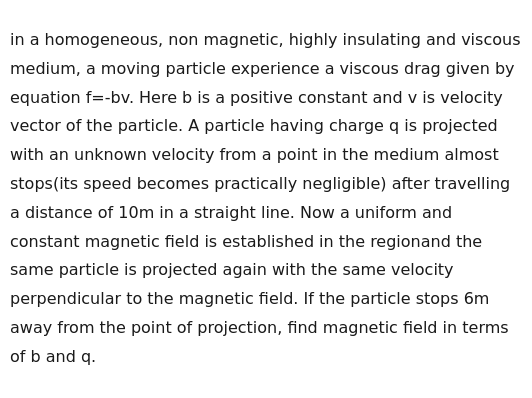Question
Question: in a homogeneous, non magnetic, highly insulating and viscous medium, a moving particle experience a...
in a homogeneous, non magnetic, highly insulating and viscous medium, a moving particle experience a viscous drag given by equation f=-bv. Here b is a positive constant and v is velocity vector of the particle. A particle having charge q is projected with an unknown velocity from a point in the medium almost stops(its speed becomes practically negligible) after travelling a distance of 10m in a straight line. Now a uniform and constant magnetic field is established in the regionand the same particle is projected again with the same velocity perpendicular to the magnetic field. If the particle stops 6m away from the point of projection, find magnetic field in terms of b and q.

B = \frac{4b}{3q}
Solution
Solution Explanation:
-
Without Magnetic Field:
mdtdv=−bv⇒v=ue−bt/m.
The drag force is f=−bv. With no magnetic field, the equation of motion isThe distance covered until the speed becomes negligible (integrated from t=0 to ∞) is
s1=∫0∞ue−bt/mdt=bum.Given s1=10 m,
bum=10⇒um=10b. -
With Magnetic Field:
mdtdv=qv×B−bv.
When a uniform magnetic field B (directed along z) is present and the particle is projected with the same speed u perpendicular to B, the force isChoosing v(0)=ux^ and B=Bz^, the components satisfy:
mdtdvx=qBvy−bvx,mdtdvy=−qBvx−bvy.Combining these into a complex equation z=vx+ivy gives
dtdz=(−mb+imqB)z,with solution
z=ue−(mb−imqB)t.The position in the complex plane is then:
r=∫0∞zdt=u∫0∞e−(mb−imqB)tdt=b−iqBum.The magnitude of the net displacement is:
∣r∣=b2+(qB)2um.Given that ∣r∣=6m and using um=10b from the first part, we have:
b2+(qB)210b=6⇒b2+(qB)2=610b=35b.Squaring both sides:
b2+(qB)2=925b2⇒(qB)2=925b2−b2=916b2.Taking the positive square root:
qB=34b⇒B=3q4b.
Answer:
B=3q4b